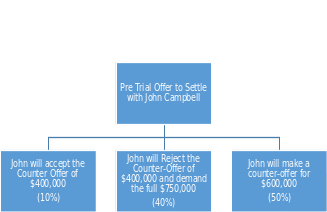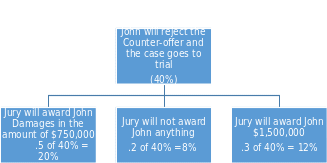

A decision tree or tree diagram is a decision support tool that uses a graph or model of the decisions and their possible consequences, including the chance of event outcomes, resource costs and utility. The decision tree is used to identify the strategy most likely to reach a specific goal.
In this case a two-step decision tree is used to determine if settling the claim of John Campbell for his asking price of $750,000 or if the alternative settlement amounts will be found acceptable. The law firm has decided to give possible success rates for each plan. Allied’s lawyers believe the probability that john will accept a counter of $400,000 is 0.10 , the probability that john will reject a counteroffer of $400,000 is 0.40, and they probability that john will , himself , make a counteroffer to allied of $600,000 is 0.50.
Therefore, there is a 40% chance of one of two outcomes. John may insist on his claim of $750,000 and receive it in order for Allied to avoid litigation. He may also insist on his $750,000 and Allied will be unwilling to settle the claim and go to trial instead. For purposes of this problem, it is assumed that if John rejects the counter-offer and does not make a counter offer of his own the case will go to trial.
Once the case goes to trial the following out comes may occur. The jury may award john damages of $750,000 is 0.50 , and the probability that the jury will award john nothing is 0.20. The chance that the Jury may chose to award John a different amount also exists. The chance of this happening is.30 the amount that they will award is $1,500,000. It is worth noting that the chance that the claim will even go to trial is only 40% as per the previous decision tree. Hence the percentages are adjusted as 20%, 8% and 12% respectively of the initial 100% chance pie.
Recommendation
The company should reject the $750,000 offer and chose to settle for the likely counter-offer of $600,000. The chance of this outcome occurring is the highest in the pretrial phrase and will be the most likely outcome that will prevent having to go to trial and incurring additional expenses like lawyer’s fees and other litigation costs. It is in the best interest of both parties that the case be resolved through settlement rather than having to go to the courts.
Decision strategy and risk profile
The decision strategy in this case will be taken from Blaise Pascal’s expected value procedure. Since there are two levels of two sets of actions the value and probability of the actions will simply be multiplied to establish the actual cost of each action.
For the first level, the pretrial level, the following expected values have been derived.
- 40% X $750,000 = 300,000 John will reject the counter offer and demand his full $750,000 claim.
- 10% X $400,000 = 40,000 John will accept the counter offer.
- .5 X $600,000 = 300,000 John make another counter offer for $600,000.
As can be seen, the expected value of decision possibility 1 and 3 are equal at 300,000 while decision 2 is a meager 40,000. There is therefore, equal probability in terms of expected value that results 1 and 3 will occur. These values are actually negative terms. The company would prefer the decision with lowest amount of money but it also has the lowest expected value and the lowest chance of actually occurring.
Result 1 can be further broken down because it is only when result 1 occurs that the trial stage will actually occur:
- $750,000 X.5 = 375,000 chance of the jury awarding John the full amount.
- 0 X.2 = 0 chance that jury will award John nothing.
- $1,500,000 X.3 = 450,000 chance that the jury will award the $1,500,000.
For purposes of deciding on the trial stage it is apparent that among the value outcome 3 is the least desirable because it has an expected value of 450,000 while outcome 2 would be best for the company as it has an expected value of 0.
As noted earlier the expected values and chance of occurring of the trial phrase decisions must be further multiplied by a factor of.4 because that is the chance that the trial will even go occur if and only if the company does not agree to settle for the $750,000 initial claim.
Given this set of facts, Allied is fortunate if John agrees to settle for the $400,000. The crisis is over. However, if he makes the counter-offer of $600,000 it is strongly recommended that Allied agree to this demand as the expected value, and the cost to the company, is still lower than the worst case scenario of the jury awarding John a full $1,500,000. Even if he demands his full $750,000 it is still recommended that the company settle because the probability of the Jury awarding nothing is very low. Furthermore, if the jury does award his full claim of $750,000 it will also cost the company lawyer’s fees and litigation fees so an award of a full-claim will still come with significantly higher costs than paying him his initial demand. Finally, there is a chance that the jury will even award him double the amount he is asking for. It is the settlement for $1,500,000 that is the least desirable result and is only possible at the trial stage and therefore, all effort must be made to prevent the case from going to trial.
The risk profiles for the individual decisions can be found in the decision tree and are expressed as the percentages that the results will occur. Using this data the most likely, and desirable, outcome is for John to agree to settle for $600,000 which is still less than the amount he originally demanded and significantly less than the highest possible amount that he might be awarded.
In conclusion, Allied must be prepared to settle at $600,000.00 or failing that even at $750,000 because a trial will open the company to greater risks and possibly even greater costs that the amount John is willing to settle for. It is prudent that the worst case scenario or the award of one million five hundred thousand dollars is avoided at all costs. Settlement at the pretrial stage has the added benefit of avoiding lawyer’s fees and other litigation costs.